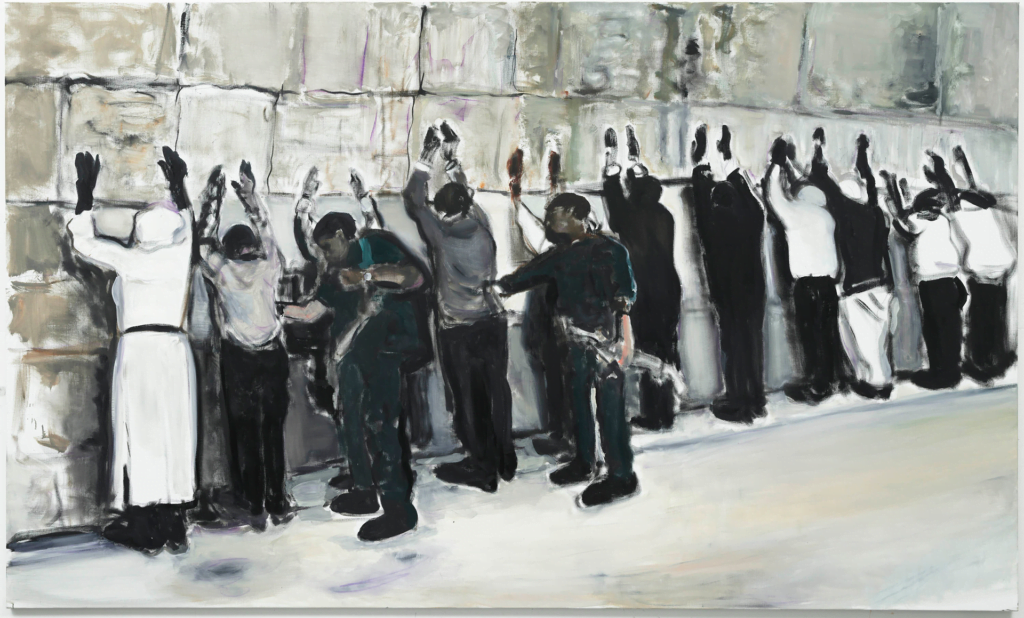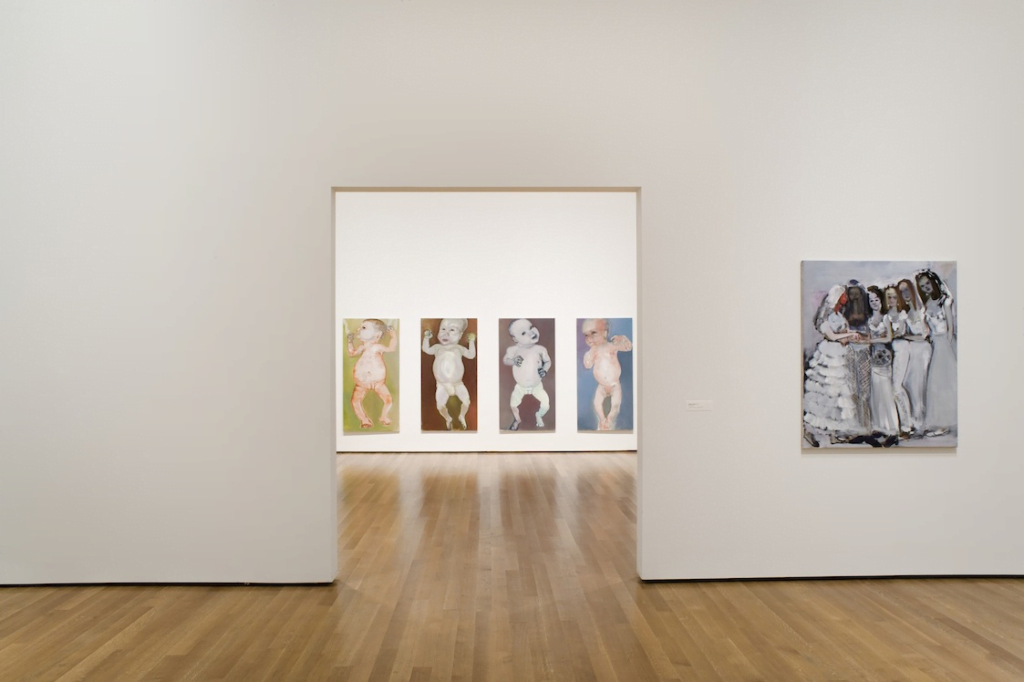You may not be familiar with Marlene Dumas, but you have likely seen her striking and provocative paintings. As one of the most influential contemporary portrait artists, her works explore themes of sexuality, race, and politics in an aggressive and mysterious way. For over 40 years, Dumas has captivated the art world with her uncanny ability to probe the depths of human psychology through her courageous and dynamic style.
Tensions around identity and place marked Dumas’s early life. She pursued her artistic talents in the Netherlands, where she studied at the Ateliers ’63 in Haarlem. Dumas went on to teach at the Ateliers, gaining notoriety for her unorthodox classroom approach and bold subject matter. By the mid-1980s, Dumas had her first solo exhibition and began receiving international acclaim for her striking portraits rendered in oil paint.
Dumas’s masterful paintings are characterized by their dynamic and conceptual depth. Her portraits possess a haunting quality that lingers in the viewer’s mind. At once confrontational and poetic, Dumas’s ability to capture the human emotions and experiences has established her as a contemporary master. Her enigmatic life and career have been as colourful and multifaceted as her prolific Work.
-
Marlene Dumas
-
Marlene Dumas Biography
-
What is Marlene Dumas known for?
-
Career Highlights
-
Marlene Dumas List of work
-
Famous Artwork by Marlene Dumas
-
Shop-Artworks-and-products-by-Marlene-Dumas
-
Dealers & Galleries
-
What could a NFT Story of Marlene Dumas sound like?
-
What could a NFT collection of Marlene Dumas look like?
-
Follow Marlene Dumas on social media
-
More about Marlene Dumas
Marlene Dumas BIOGRAPHY

Early Life and Artistic Influences: Marlene Dumas’ Upbringing in South Africa
Dumas was born in Cape Town city of South Africa during the apartheid era in 1953. Dumas’s family moved to Kuils River, a small rural town when she was a child. There, Dumas developed an interest in art at a young age under the guidance of her mother, a piano teacher.
Where did Marlene Dumas Go to School?
As a teenager, Dumas took private art lessons from poet and painter W.H. Smith, who introduced her to expressionism and encouraged her artistic pursuits. Marlene went on to study fine arts at the University of Cape Town, where she was exposed to social realism and confronted the political issues surrounding apartheid. These experiences shaped her socially conscious artistic style and choice of subjects, like politics, identity, and human relationships.
After graduating in 1975, Dumas moved to the Netherlands to pursue a master’s degree. There, she was influenced by Dutch masters like Rembrandt and German expressionists. Marlene settled in Amsterdam, where she still lives and works today.
Dumas’s upbringing in South Africa’s turbulent political climate and training in humanist European artistic traditions shaped her unique painting style. By confronting controversial social issues through emotionally evocative portraiture, Dumas has established herself as a pioneering contemporary artist and one of the most influential portraitists of her generation.
What is Marlene Dumas known for?

The life and Work of Marlene Dumas represent a compelling enigma. In a career marked by creative experimentation and boundary-pushing, Dumas cemented her place as one of the most important contemporary artists.
Though her paintings often depict dark and disturbing scenes, Dumas sees her art as a way to foster empathy and bring marginalized subjects into the light. As her Work continues to garner international acclaim in the years to come, Dumas’s brilliant and unflinching gaze upon humanity will undoubtedly inspire future generations of artists and art lovers alike.
Career highlights

Artistic Style and Themes
Marlene Dumas is known for her aggressive and controversial figurative paintings that explore themes of identity, politics and sexuality.
Dumas works primarily with oil paint on canvas, utilizing a muted colour palette and rough, expressive brushstrokes. Her paintings have a raw, unfinished quality that gives them a sense of emotional immediacy. Dumas is fascinated by the psychological aspects of human existence, and her works often depict fragmented body parts, especially faces and hands, in a disturbing and compelling way.
Exploring Identity and Politics
Many of Dumas’ paintings examine issues of race, gender and power. Her subjects are often black men and women, portrayed in a manner that challenges stereotypical representations. Works such as “The White Disease” critique racism and apartheid in her native South Africa.
Depicting Sexuality
Dumas frequently paints nudes and explores human sexuality in an aggressive and ambiguous way. Her paintings often depict fragmented body parts in erotic poses, fusing elements of pornography, voyeurism and fetishism. However, her works stop short of becoming explicitly graphic or gratuitous. Instead, Dumas uses sexuality to examine broader themes of intimacy, relationships and human psychology.
How does Marlene Dumas create her Work?
First and foremost, Dumas starts with an idea or concept she wants to explore. It could be a specific theme or emotion that she wants to convey through her art. She then begins the creative process by sketching out rough ideas and compositions. These sketches serve as a starting point for her paintings.
Once she has a clear vision in mind, Dumas begins to work on a larger scale. She typically uses a mix of oil and watercolour paints, using bold brushstrokes and layers of colour to create depth and texture in her pieces. Dumas is known for her ability to capture her subjects’ raw emotions and vulnerabilities, often focusing on themes of identity, sexuality, and societal issues.
In addition to her painting techniques, Dumas also incorporates found images and photographs into her Work. She often collects images from various sources, such as newspapers, magazines, and personal pictures, which she then uses as references or inspiration for her paintings.
Marlene Dumas List of Work

Major Works
Through her evocative and politically charged paintings, Marlene Dumas has established herself as one of the most prominent contemporary portraitists. Her unflinching and, at times, controversial art challenges viewers to explore complex questions of identity, race and human existence.
Some of his major paintings include:
1994 | The Painter |
1995 | The Visitor |
1983 | The Futility of artistic confession |
1988 | Snow white in the wrong story |
2013 | The Present One |
2015 | Skulls |
Exhibitions
Dumas is revered as a pioneer in contemporary portraiture. Her paintings can be found in significant museum collections, including:
Museum of Modern Art in New York
Tate Modern in London
Center Pompidou in Paris
Dumas continues to push the boundaries of portraiture, incorporating poetic and mysterious elements into her works. Through her masterful and unflinching paintings, Dumas has impacted the art world that will endure for generations. Her career stands as an inspiration.
What Inspired Marlene Dumas?
One of Dumas’s primary sources of inspiration is her personal experiences and emotions. She often draws from her memories, feelings, and observations of the world around her. Her art becomes a way for her to express her thoughts and ideas, to process her own experiences, and to explore complex societal issues.
The human condition also inspires Dumas. She is fascinated by the complexities of human emotions and how we navigate the world. Her paintings often depict ambiguous and evocative figures, capturing a range of emotions and psychological states. Through her art, she aims to capture the essence of what it means to be human.
In addition to her personal experiences and the human condition, Dumas draws inspiration from a wide range of sources. She is influenced by literature, poetry, film, and music. She also looks to the Work of other artists, both contemporary and historical, for inspiration and guidance. She often references art history and uses it as a starting point for her explorations.
Critical Acclaim and Legacy: From Controversial Beginnings to Renowned Contemporary Painter
Marlene Dumas has cemented her status as one of our time’s most prominent portrait artists. Though her paintings were initially met with controversy, Dumas pushed through criticisms to gain international recognition.
Early in her career, Dumas’ unapologetic and politically charged works featuring graphic sexuality and violence sparked outrage. Her pieces explored taboo themes that confronted viewers, eliciting visceral reactions. Despite the initial controversy surrounding her paintings, Dumas persisted in creating confrontational art that tackled complex subjects.
Dumas’ perseverance and dedication to her craft ultimately paid off. Her paintings received widespread critical acclaim in the late 1980s and early 1990s and were featured in worldwide exhibitions. Dumas was praised for her vibrant, expressive style and ability to capture her subjects’ psychological essence. Museums started actively collecting her pieces, cementing her status as an influential contemporary artist.
Famous Artwork by Marlene Dumas
Shop Artworks & NFT’s BY Marlene Dumas
Dealers & Galleries
What could a NFT Story of Marlene Dumas sound like?
What could a NFT collection of Marlene Dumas look like?
Follow Marlene Dumas on social media
Instagram
Facebook
Twitter
Youtube
TikTok
LinkedIn
